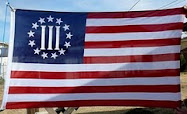http://diasporaperuananewyork.blogspot.com/2009/06/indigenous-uprising.html
On June 6, near a stretch of highway k nown as the Devil’s Curve in the northern Peruvian Amazon, police began firing live rounds into a multitude of indigenous protestors — many wearing feathered crowns and carrying spears. In the neighboring towns of Bagua Grande, Bagua Chica and Utcubamba, shots also came from police snipers on rooftops, and from a helicopter that hovered above the mass of people. Both natives and mestizos took to the streets protesting the bloody repression. From his office in Bagua a representative for the international organization “Save the Children” reported that children as young as four years-old were wounded by indiscriminate police shooting. President Alan García had hinted the government would respond forcefully to “restore order” in the insurgent Amazonian provinces, where he had declared a state of siege on May 9 suspending most constitutional liberties. The repression was swift and fierce.
nown as the Devil’s Curve in the northern Peruvian Amazon, police began firing live rounds into a multitude of indigenous protestors — many wearing feathered crowns and carrying spears. In the neighboring towns of Bagua Grande, Bagua Chica and Utcubamba, shots also came from police snipers on rooftops, and from a helicopter that hovered above the mass of people. Both natives and mestizos took to the streets protesting the bloody repression. From his office in Bagua a representative for the international organization “Save the Children” reported that children as young as four years-old were wounded by indiscriminate police shooting. President Alan García had hinted the government would respond forcefully to “restore order” in the insurgent Amazonian provinces, where he had declared a state of siege on May 9 suspending most constitutional liberties. The repression was swift and fierce.
By the end of the day a number of government and the president’s party APRA offices were destroyed, 9 policemen and approximately 40 protesters were killed. Overwhelmed by the number of the wounded small local hospitals were forced to close their doors. A doctor in Bagua Grande described the repression as a “barbarian act” similar to those committed in Beirut by the Israeli occupying forces a few years ago. A Church official denounced that many of the civilian wounded and killed at the Devil’s Curve were forcefully taken to the military barracks of El Milagro. From Bagua, a local journalist declared to Ideele Radio that following the killings policemen dumped bagged bodies in the Utcubamba River. Indigenous leaders have accused García of “genocide” and have called for an international campaign of solidarity with their struggle. Indigenous unrest in the Peruvian Amazon began late last year. After an ebb of a few months, the uprising regained force again on April 9. Since then, Amazonian indigenous groups have sustained intensifying protests for more than two months, including shutdowns of oil and gas pumping stations as well as blockades of road and river traffic.
The Devil’s Curve massacre is not the only instance of repression. García recently sent in the Navy to violently break through indigenous blockades on the Napo River, also in northern Peru. But few expected such a violent reaction from the government. García says the response was appropriate and blamed the indigenous for thinking they could decide what happens in their territories: “These people don’t have crowns. They aren’t first-class citizens who can say… ‘You [the government] don’t have the right to be here.’ No way.” The president called the protestors “pseudo-indigenous.” MORE HERE
























